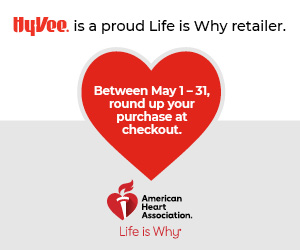Writer: Mathany Ahmed
Earlier this year, the “Map the Meal Gap” report revealed the worsening reality of Iowa’s hunger crisis. The annual report from the nonprofit Feeding America showed that nearly 11% of Iowans — about 344,550 people — don’t know where their next meal is coming from. More than 110,500 of those Iowans are children.
For a closer look at the numbers, we sat down with Annette Hacker, the Food Bank of Iowa’s vice president of communications.
“Food insecurity was already high during COVID-19, but it began to subside a bit in late 2021 and early 2022,” she said. “Then, as pandemic-era relief programs ended in April 2022, we saw a consistent monthly rise in food insecurity. It’s been skyrocketing ever since.”
In 2023, the Food Bank of Iowa distributed 30% more food — more than 22.5 million pounds — than the previous year. Certain areas have been hit especially hard, including Lucas and Clarke counties in south central Iowa, where food insecurity rates top 13%.
“People are struggling,” Hacker said. “We’ve got high inflation, and grocery prices have increased 25% in the last four years. Wages just haven’t kept up with the cost of living.”
Children are at higher risk for hunger. More than 15% of Iowa’s kids — 1 in 6 — face food insecurity, and they account for 43% of the Food Bank of Iowa’s recipients statewide.
To help, the Food Bank of Iowa’s Backpack Program sends 4,100 elementary school students at 103 schools home with 14 food items each Friday.
And the food bank’s programs benefit more than individual students. “If there’s one hungry kid, there are probably other siblings, parents and caregivers at home who are also food insecure,” Hacker said. “Our goal is to have a school pantry in every district we represent and in every public school or facility.”
Nearly $246 million is needed to resolve the state’s food needs, a staggering sum that can make the average Iowan feel overwhelmed by the scale of the problem. While the causes of food insecurity are often structural, individuals can still make a difference when they pitch in. “Nobody can do it all, but everybody can do something,” Hacker said.
How you can help
Donate funds
“We can do the most with money,” Hacker said. Financial donations allow food banks to buy what they need in bulk, which helps stretch every dollar. At the Food Bank of Iowa, 96 cents of every dollar goes toward feeding someone in need. “Instead of buying a can of vegetables for a dollar at the store,” Hacker said, “we can buy five cans with that same dollar.”
Donate food
Nonperishable food donations like canned vegetables, pasta, rice and cereals are always in demand. Check with your local food bank to see what items they need most.
Volunteer your time
If you want a hands-on way to help, consider volunteering. You can help sort and pack food, distribute meals or assist with administrative tasks. “Volunteering at the food bank is a really fun and rewarding experience,” Hacker said. “If you ask any of our volunteers, they’ll say if you try it once, you’ll be hooked.”
Advocate for policy changes
“The problem is poverty,” Hacker said. “It’s not a coincidence that 11% of people in this state live in poverty, and 10.8% of them are food insecure.” Coming together as a community to advocate for policy changes can create lasting changes that can alleviate poverty, and by extension, hunger.
For more information on how you can help, visit the Food Bank of Iowa’s website at foodbankiowa.org.
Iowa Stops Hunger is an ongoing Business Publications Corp. initiative to raise awareness about food insecurity in Iowa and inspire action to combat it.











